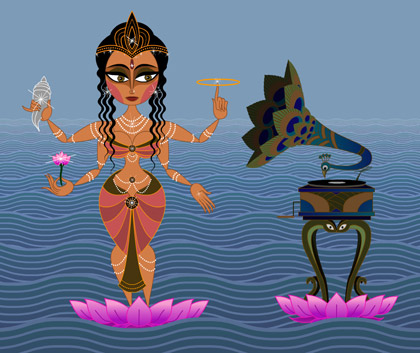Friday, March 30, 2007
Quote of the Day
"There are three things which are real: God, human folly, and laughter. Since the first two pass our comprehension, we must do what we can with the third."--Aubrey Menen
The son of an Indian father and Irish mother, Aubrey Menen was born (1912) in London and died (1989) in Thiruvananthapuram. In India during World War II, he organized pro-Allied radio broadcasts and edited film scripts for the Indian government. He wrote many books including a satirical Ramayana, from which the quote above is taken. The book is banned in India.
Saturday, March 24, 2007
Art
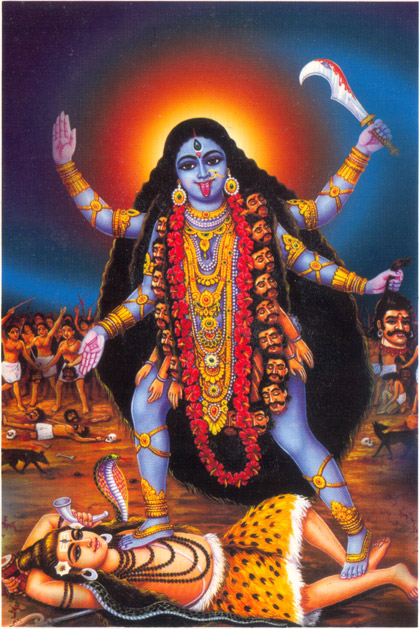
Kali Ma
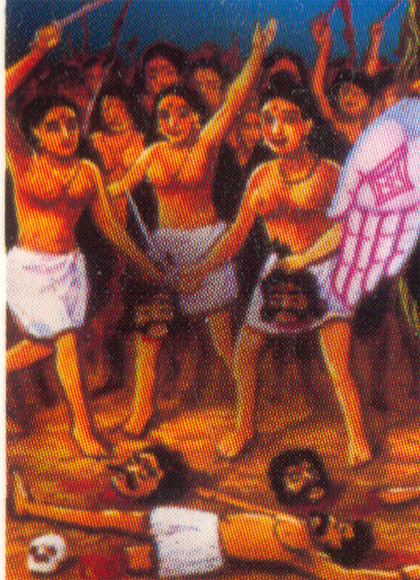
Kali's helpers (detail)

Coatlicue
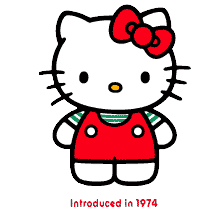
Hello Kitty
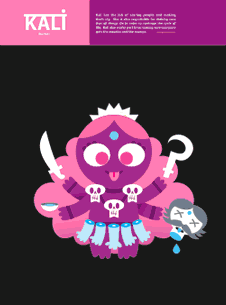
Kali Ma
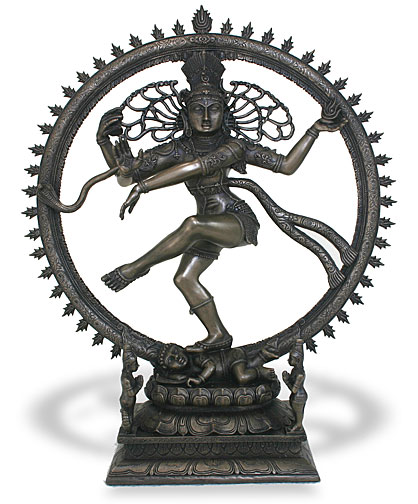
Shiva Natraj
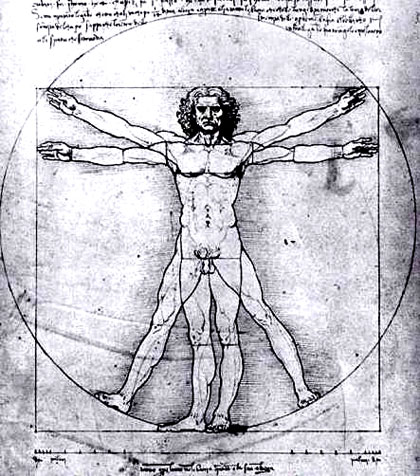
White Male Imperialist Cultural Appropriation (kidding! I keed!)
Thursday, March 22, 2007
Meanwhile, in another part of the web...
Sepia Mutiny has an article and 240-post discussion about my picture of Desire/Kali, cultural ownership, the role of art and artists, "critical race analysis of your work in a postcolonial context," and more. Unfortunately the comments are now closed and I lost my cool and brought down the level of discourse at one point, but overall commenters were remarkably articulate and civil, and covered a broad range or related issues. Big thanks to everyone over there who took the time to contribute.
Thursday, March 15, 2007
...and weighing in from another side:
Chennai's News Today brings us this story: Ramayana will be burnt, says Veeramani. Via Sepia Mutiny.
Tuesday, March 13, 2007
I'm probably only encouraging them, but...
...this email I got today from Mrunal Nanivadekar of the anti-speech HinduJagruti.org was too good not to share.||Sree||
Ms. Paley,
Some irate Hindus have brought to our attention your attempt ("Sitayana") at retelling the Hindu Holy epic, Ramayana ( www.ninapaley.com/Sitayana).
Here are our concerns regarding your attempt:
Ø It appears that you are not fully aware that the Ramayana is a Holy Scripture for Hindus. Over a billion Hindus all over the world hold it in reverence. What you call as the characters in Ramayana are divine Incarnations worshipped by Hindus.
Ø While we understand your painful personal incidents discussed on your site, your "Sitayana", which basically re-tells the Ramayana as matches your own life, is contrary to the life of Lord Rama and Goddess Sita as given in the Hindu Holy texts. Thus, even if inadvertently, your "Sitayana" has proved to be deliberately disrespectful and downright denigrating to Hindus at large.
Ø One cannot understand divine Incarnations by trying to fit them into limited human paradigms. It takes rigorous spiritual practice to attain the spiritual maturity to understand and experience the attributes and functions of divine Incarnations.
Ø Even if one were to hold such views in private, out of lack of knowledge or understanding, you have gone on to publicly display your views on the World Wide Web. To publicly comment on something held in reverence by many, one should have some authority on the subject. Kindly let us know what spiritual authority you exercised to publicly alter and mock a Holy spiritual text revered by millions?
Ø If there is anything that the worldwide violence over Prophet Mohammed's caricatures has taught us, it is that religious sentiments are the most sacred of all to those who follow any religion. Denigrating them as the likes of the Danish cartoonists have done, or disregarding them as the likes of the Danish press have done, can incite communal disharmony, if not widespread violence. That is why, the UN ex-Secretary General, Kofi Annan in view of the crisis over caricatures of Prophet Mohammad has advocated that, "We must stress that rights carry with them an inherent responsibility, and should not be used to degrade, humiliate or insult any group or individual."
Ø You are well aware that had you used an Islamic Holy Scripture for retelling on the lines of personal incidents, you would have violent agitations on your hands by now. Is this to incite the usually tolerant Hindus to take up violence to protect their religious sanctity?
In light of the above, we request you to prevent further hurting of Hindu sentiments by immediately removing the "Sitayan" from public display and publishing an unconditional apology in its place, so as to prevent a public protest campaign and furore from the Hindu community worldwide.
Expecting your prompt action and response,
Mrunal Nanivadekar
5159885161
PR Manager, USA Chapter
www.HinduJagruti.org
I was disappointed I wasn't listed on the main defamations page, but only the lower-tier defamations reported by visitors page. Oh well, we can't all be M.F. Hussain.
Sunday, March 04, 2007
Doordarshan don't darshan
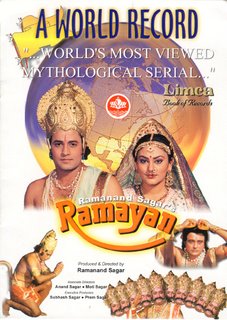 I've spent the last several weeks watching the Ramanand Sagar / Doordarshan Ramayan TV series on DVD (thanks, Sendhil!). Not all 78 hours - I skipped a few volumes. But I learned plenty:
I've spent the last several weeks watching the Ramanand Sagar / Doordarshan Ramayan TV series on DVD (thanks, Sendhil!). Not all 78 hours - I skipped a few volumes. But I learned plenty:*Rama's portrayal is convincingly righteous, even to a crankypants like me
*Sita really does cry constantly through the second half of the series (about 36 hours)
*The show is a study in the slowest, most drawn-out "action" I've ever seen
*You can never have too many zoom-ins
Suspiciously, the episode I most wanted to see was missing from the set. That's right, MISSING. The DVD code suddenly got gunged up right before the part where Sita should have gone through fire. No matter how many times I cleaned and reinserted the disc, it was impossible to play. Since that's the most controversial scene in the series, I wouldn't be surprised if it were rendered intentionally unplayable on the DVD. In spite of the crucial scene missing, I did get to see Rama defend his plan to put Sita through fire, using the Tulsi Das Rationalization. See, Rama knew Sita was going to be abducted, so before Ravana even showed up he asked Agni, the fire god, to protect Sita. So Sita enters Agni's protection (ie, burns up), leaving behind a "shadow Sita." It's the shadow that gets abducted, imprisoned, etc. (and cries for 36 hours). Once Rama rescues her, he needs to replace the "shadow" Sita with the real Sita - again by putting her through fire. See? Only the best intentions.
Naturally I turned to youtube to search for the missing scene. Instead I found something better: scenes from the sequel, "Luv Kush," aka the Uttara Kanda. I had no idea Doordarshan ever produced that! The Uttara Kanda is the highly controversial last book of the Ramayana, missing from Tulsi Das's commentaries and most mainstream versions, like the original Ramayan series. It's the part where Rama banishes Sita and she eventually returns to Mother Earth. It's what half my movie is based on. And here it is, Doordarshan style:
There are no subtitles, but I assume Valmiki is presenting the much-maligned Sita to Rama, and defending her virtues. Rama, I assume, says, "I'll take the boys, but Sita's gonna have to prove her purity again." Then Sita drops the big one, probably the equivalent of: "If I have always been true to Rama, may Mother Earth take me back into her womb." Which happens:
If anyone wants to leave translations of the Hindi in the comments, I'd be much edified.
Thursday, March 01, 2007
Mixed Review
From yesterday's inbox:HEY NNA PALEY I REALLY LIKED THE RAMAYAN YOU DID I THINK THE SITA YOU CREATED WAS ALSO PRETTY CAN YOU SEND ME A PICTURE OF HER BUT DID YOU HAVE TO MAKE SITA TOO REVEALING I GOT INSULTED WHEN I SAW THAT IM A HINDU AND THAT WAS INSULTING KEEP UP THE GOOD WORK BUT DONT BE REVEALING NEXT TIME THANKYOU
Thanks, and keep those cards and letters coming!
Praising with Great Damnation
Sometimes the greatest compliment comes in the form of being hated by the right people. So I was thrilled to discover this condemnation from the Forced-Birthers, who only took five years to notice my work exists. Five years, but so worth the wait.
